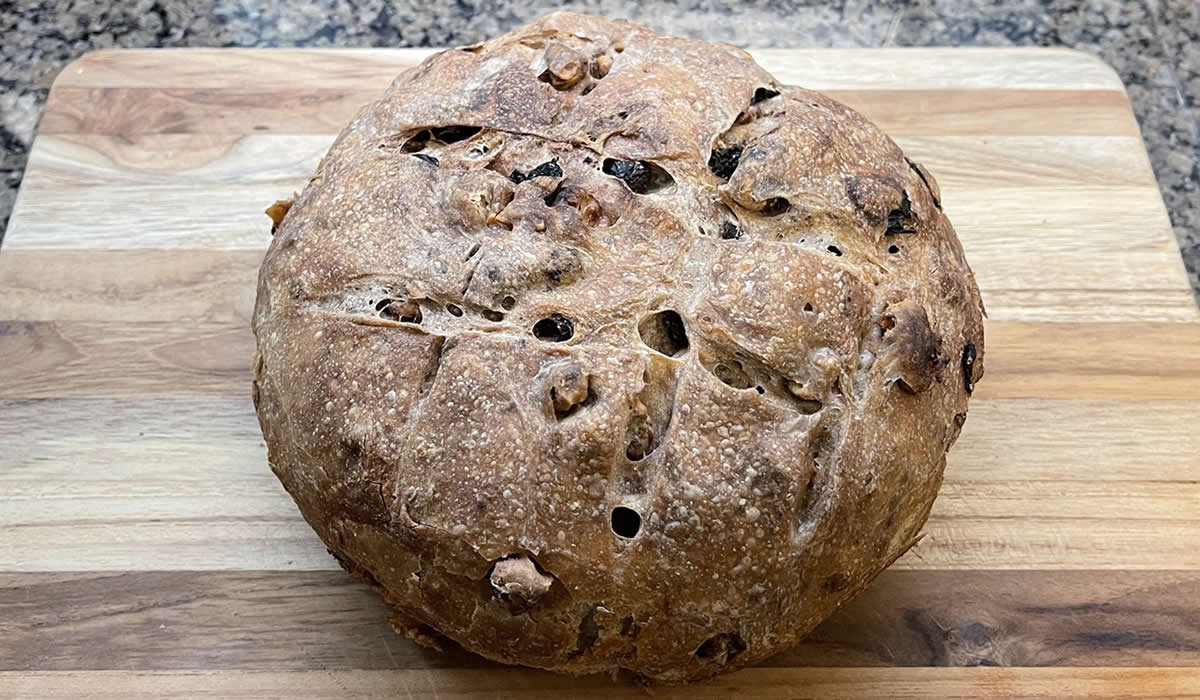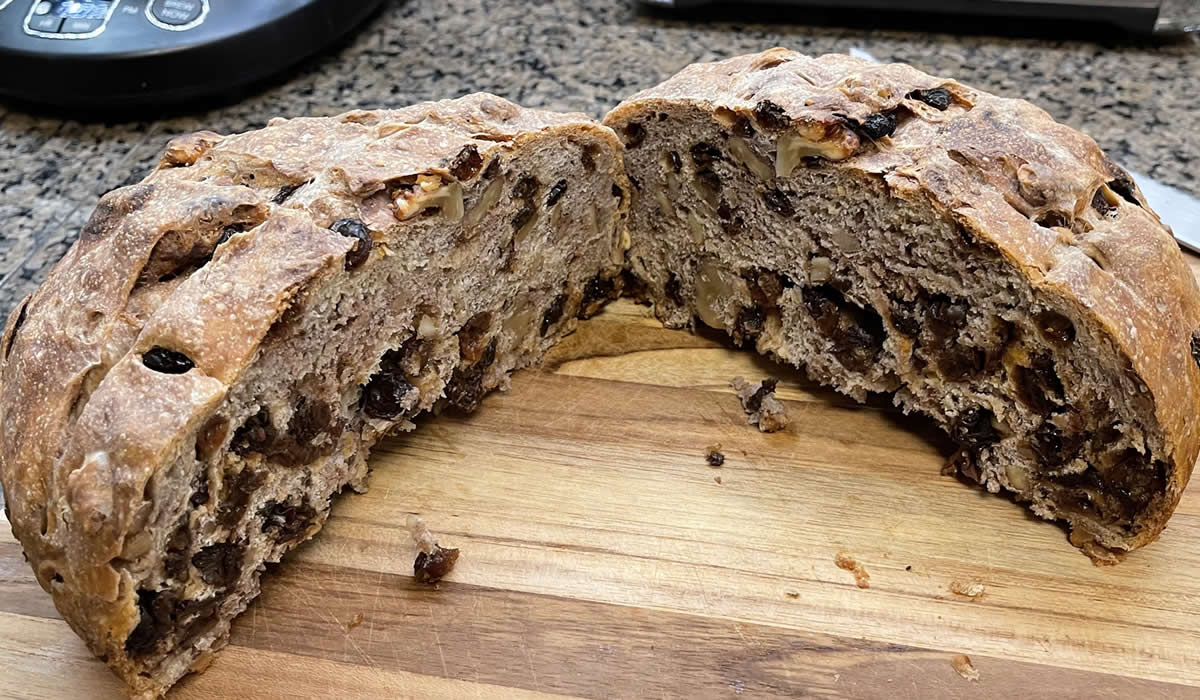I received a King Arthur Flour magazine in the mail the other day… I generally like King Arthur recipes and the first one I saw in the magazine – which is actually more buy this than recipes – was for a No-Knead Harvest Bread.
 I was a big fan of the no-knead bread craze several years back but haven’t made any in several years. Glancing through the recipe, it seemed like an easy way to get back into the swing of things…
I was a big fan of the no-knead bread craze several years back but haven’t made any in several years. Glancing through the recipe, it seemed like an easy way to get back into the swing of things…
The recipe was designed around their No-Knead Harvest Bread Bundle – a whole bunch of stuff I already have or don’t need. For $106.70, you get:
- Bread Baking Bowl (2¾” x 8″; 10¼” with handles)
- King Arthur Bowl Scraper
- Standard Dough-Rising Bucket (2 qt.)
- King Arthur Straight Walnut Lame
- Baker’s Fruit Blend (16 oz.)
- SAF Red Instant Yeast (16 oz.)
- Printed Recipe
That’s a lot of money for not a lot of stuff. But I digress…
The recipe called for 160gr of their Baker’s Fruit Blend – raisins, apricots, peaches, pears, nectarines, and cranberries – assorted dried fruit. I didn’t have all of their variety, but I did have two types of raisins. ‘Nuff said. Time to get to work.
No-Knead Harvest Bread
adapted from King Arthur Flour magazine
- 3 1/4 cups (390g) King Arthur Unbleached Bread Flour
- 1 cup (113g) King Arthur Whole Wheat Flour
- 2 teaspoons (12g) salt
- 1/2 teaspoon instant yeast
- 1 3/4 cups (397g) cool water
- 1 1/4 cups (160g) Baker’s Fruit Blend
- 1 cup (113g) coarsely chopped pecans or walnuts
Weigh your flour; or measure it by gently spooning it into a cup, then sweeping off any excess. Mix the flours, salt, yeast, and water in a large bowl. Stir, then use your hands to bring the sticky dough together, making sure to incorporate all of the flour.
Work in the fruits and nuts.
Cover the bowl with plastic wrap and let the dough rest at room temperature overnight, or for at least 8 hours; it’ll become bubbly and rise quite a bit, so use a large bowl.
Turn the dough out onto a lightly floured surface, and form it into a round loaf to fit your bread bowl.
Place the dough in the lightly greased pan, smooth side up.
Cover and let rise at room temperature for about 2 hours, until it’s become puffy. It should rise noticeably, but won’t quite double in size. Toward the end of the rising time, preheat the oven to 425°F. When you’re ready to bake, place a pan with 1/2″ of hot water on the bottom or lowest rack of the oven and close the door.
Using a sharp knife or lame, slash the bread in a crosshatch pattern. Put the bread in the oven and set a timer for 15 minutes.
After 15 minutes reduce the oven temperature to 375°F and bake for another 35 to 40 minutes, until the bread is deep brown in color, and a digital thermometer inserted into the center registers about 205°F.
Remove the bread from the oven, turn it out onto a rack, and cool completely before slicing.
It had a great crusty crust and excellent flavor. My biggest complaint was the bread stuck to my cooking bowl. It was probably more user error because I probably had too many raisins on the bottom. I thought I had mixed it well, but looking at the photo, I definitely could have done better. And… I used a deeper bowl than the one they were selling. I didn’t see measurements of the bowl and went with what I have used in the past – albeit slightly differently. Still, it tasted great – and made excellent toast, this morning!
I went to the King Arthur website and found a recipe for the same bread – well almost the same bread – using raisins and cranberries – not the Bakers Fruit Blend – and a totally different baking process.
No-Knead Harvest Bread
adapted from King Arthur Flour website
- 3 1/4 cups (390g) King Arthur Unbleached Bread Flour
- 1 cup (113g) King Arthur Whole Wheat Flour
- 2 teaspoons (12g) salt
- 1/2 teaspoon instant yeast
- 1 3/4 cups (397g) cool water
- 3/4 cup (85g) dried cranberries
- 1/2 cup (85g) golden raisins
- 1 cup (113g) coarsely chopped pecans or walnuts
Weigh your flour; or measure it by gently spooning it into a cup, then sweeping off any excess. Mix the flours, salt, yeast, and water in a large bowl. Stir, then use your hands to bring the sticky dough together, making sure to incorporate all of the flour.
Work in the fruits and nuts.
Cover the bowl with plastic wrap and let the dough rest at room temperature overnight, or for at least 8 hours; it’ll become bubbly and rise quite a bit, so use a large bowl.
Turn the dough out onto a lightly floured surface, and form it into a log or round loaf to fit your 14″ to 15″ long lidded stoneware baker; 9″ x 12″ oval deep casserole dish with cover; or 9″ to 10″ round lidded baking crock.
Place the dough in the lightly greased pan, smooth side up.
Cover and let rise at room temperature for about 2 hours, until it’s become puffy. It should rise noticeably, but it’s not a real high-riser.
Using a sharp knife or lame, slash the bread in a crosshatch pattern. Place the lid on the pan, and put the bread in the cold oven. Set the oven temperature to 450°F, and put the bread into the oven.
Bake the bread for 45 to 50 minutes (start the timer when you place the bread into the cold oven). Remove the lid and continue to bake for another 5 to 15 minutes, until it’s deep brown in color, and a digital thermometer inserted into the center registers about 205°F.
Remove the bread from the oven, turn it out onto a rack, and cool completely before slicing.
Store the bread, well wrapped, at room temperature for several days; freeze for longer storage.
I like this recipe much more. It’s actually easier and closer to the no-knead breads I’ve made in the past.
I’ll definitely make this one, again – it’s very reminiscent of a walnut raisin bread baked by LeBus Bakery in Philadelphia. And I’ll follow the second recipe – not the first.
The impetus for baking bread was Victor making a clean out the ‘fridge pasta dinner.
A really simple dish of pancetta, grape tomatoes, zucchini, garlic, olive oil, and cheese.
Perfection on a plate.
2 Comments
Add comment
This site uses Akismet to reduce spam. Learn how your comment data is processed.



Hi darlin’….I remember years ago using a recipe that called for raisins….with instructions to toss them with a bit of flour before you mix them into the dough. Rather like powdering your face! I recall that it worked quite well. Can’t even recall what the recipe was….but the raisins did not clump together or fall the the bottom. For some reason pumpkin or another sweet bread comes to mind…. Maybe you can try that next time? xoxoxD
That definitely works for batters – as in a cake, loaf bread, or some such thing. It tends to hold them in place.
Things don’t tend to sink in a dough. This was a mix-by-hand recipe – and I just didn’t mix it by hand well enough! LOL
User error!